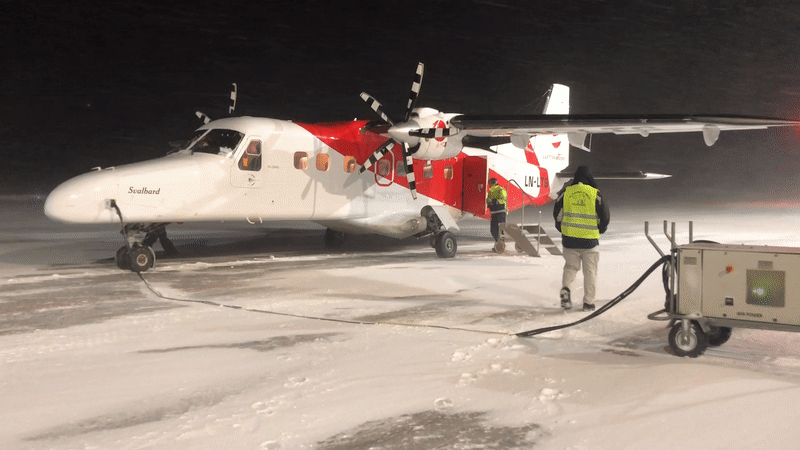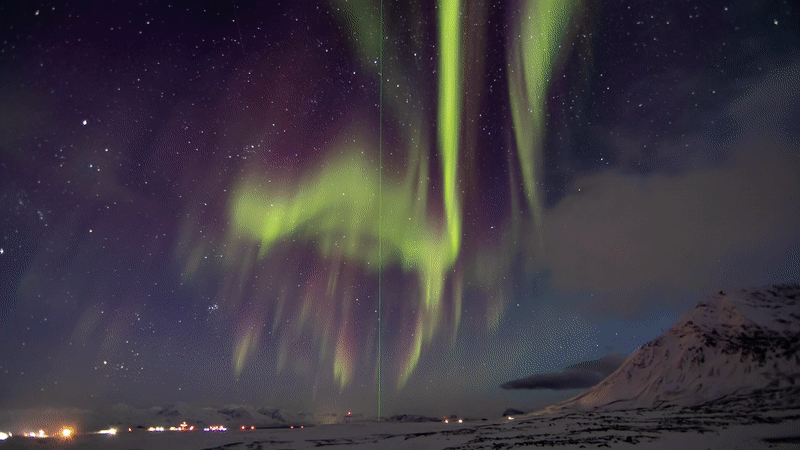A SHOT IN THE DARK
Chasing the aurora from the world’s northernmost rocket range
In the tiny Arctic town of Ny-Ålesund, where polar bears outnumber people, winter means three months without sunlight. The unending darkness is ideal for those who seek a strange breed of northern lights, normally obscured by daylight. When these unusual auroras shine, Earth’s atmosphere leaks into space.
NASA scientists traveled to Ny-Ålesund to launch rockets through these auroras and witness oxygen particles right in the middle of their escape. Piercing these fleeting auroras, some 300 miles high, would require strategy, patience — and a fair bit of luck. This is their story.
Listen to this story
Part I
I • II • III • IV • V • VI • VII

When the bus finally came to a stop, they found themselves inside a glass-walled garage. A man was standing inside.
“Welcome to Ny-Ålesund!” the man cheered. His messily-parted, shoulder-length brown hair would fit in on tour with a heavy metal band. But this was Doug Rowland, NASA rocket scientist, and the team’s leader. He was the one who had called them to meet in this cold, dark, and strangely beautiful place.
The newcomers stepped off the bus and into the garage’s light. Among the first was Sophie Zaccarine, who waved hello to Rowland with both arms overhead. A 21-year-old engineering physics major, Zaccarine would monitor one of the scientific instruments during the flight. Over the past three years, she had worked through summer internships and short visits to NASA to design and build a small electronics enclosure that, very soon, would become her first bit of hardware in space. Robert Pfaff strode in later, nodding at staff as he passed them. Pfaff was a co-investigator, in charge of one of the experiments, and a veteran rocket man. He led the very first NASA launch from this remote arctic town in 1997, and has launched more rockets here than anyone else at the agency.
As Rowland greeted each of the 11 new arrivals, he appeared visibly relieved — his science team was finally here. Rowland had been on the island for a few weeks already, helping to reassemble the two rockets after they had traveled across the Atlantic Ocean in pieces, by cargo ship. Today, after three years of development, they now stood fully-assembled and ready at the launchpad a few miles away. But soon they would be much farther, some 300 miles high, flying through an aurora. If all went as planned.
The science team had landed in Ny-Ålesund, the northernmost civilian settlement in the world. A tiny research town on the Norwegian Archipelago of Svalbard, it is a place where trees do not grow. The only fresh food arrives by cargo ship after a voyage across arctic waters. During winter months, Ny-Ålesund’s resident population drops to 30 for the dark season, which is when the team had arrived. It was December. For the next three months, the Sun wouldn’t rise.
Daytime darkness was important, for only against a dark backdrop could the special aurora borealis they sought be seen with the naked eye. But the main reason for coming to this place was not the dark sky, per se. It was what transpired far above it.

Between the daytime hours of 10 a.m. and noon, a magnetic portal to space passes over Ny-Ålesund. For those two hours, the barrier between sky and space is at its thinnest. Energetic particles normally deterred by Earth’s magnetic field rush into Ny-Ålesund’s air. They strike atmospheric gases, setting the sky alight with auroras that shine during the day. But the strangest thing about these auroras is not visible at all. Inside them, gases are beginning to cook, and some reach their boiling point. Through these auroras, massive amounts of oxygen are boiled away to space.
The process is known as atmospheric escape. It has been happening on Earth for billions of years, and will continue for a billion more — a timescale too long to impact humans. Yet the physical reactions set forth inside these auroras are cogs in the much larger machine of atmospheric change. Over time, they have transformed Earth from a molten ball of magma into the rich, balanced catalyst for life that it is today. To understand atmospheric escape is, in part, to understand how we got here.
So these NASA-funded researchers traveled to Ny-Ålesund to study these auroras and the oxygen they set free. They wanted to understand the precise mechanism of heating, and better quantify exactly how much oxygen is lost this way. In pursuit of these questions, they came armed with the heavy artillery of their trade. They would shoot scientific rockets into the aurora, measuring the oxygen right as it started to escape.
It would take a large team, some sixty-one members in all, each with their own set of skills and responsibilities. Some would monitor the rockets and the precious scientific instruments they carried. Others studied the sky to forecast when to launch. Yet others would coordinate these teams, ensuring each step was taken at the right time and in the proper order. But together, with good timing and a healthy dose of luck, they would attempt to place scientific instruments inside an active aurora. They would watch, up close, how bits of Earth’s atmosphere escape to space.
